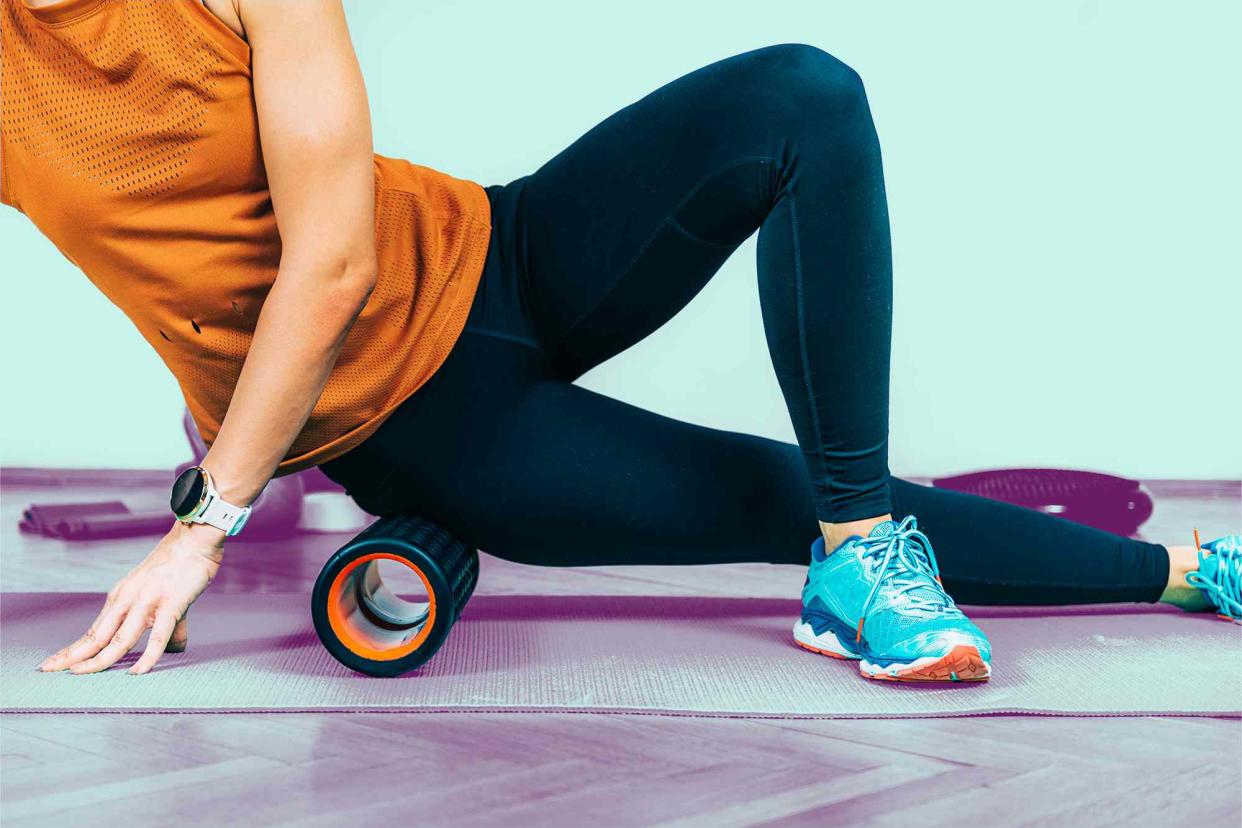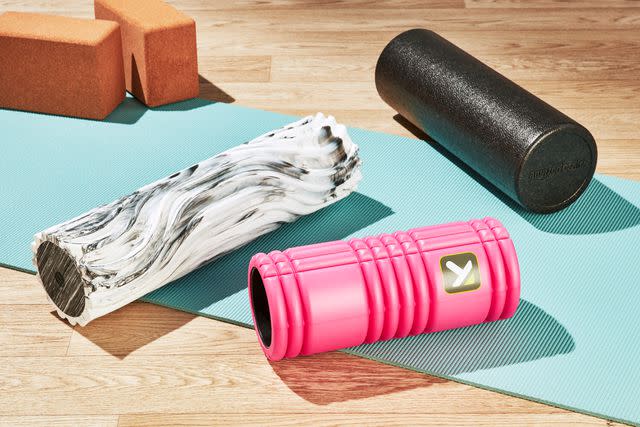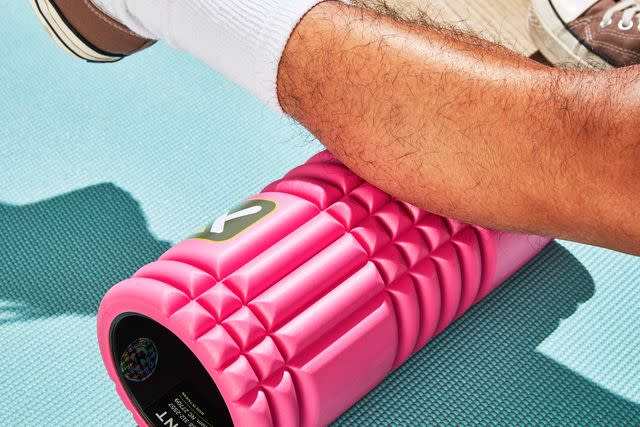The Ultimate Guide to Foam Rolling

Medically reviewed by Kristin McGee, CPT
Recent advances in sports science suggest that muscle tightness can limit life activities—even in young people who typically heal fast. Taking immediate action to mitigate tension, such as by incorporating foam rolling into your workout routine, can have positive impacts not only on your sports performance but also in your day-to-day life.
Foam rolling—also called self-myofascial release—is a self-massage technique targeting the fascia (the connective tissue around the muscles) and can help release built-up tightness from overuse, weakness, and repetitive movements. Think of it as getting a massage—the masseuse applies pressure to your body to work out “knots” and get you relaxed.
Foam rolling works the same way. You manipulate muscle tissue to loosen up your body and enhance your range of motion. Learn more about the purpose of foam rolling and how to incorporate it into your workout regimen.
What Does Foam Rolling Do?
Foam rolling is a popular self-massage technique that complements traditional massages and stretching routines. It can also benefit all levels of fitness, from weekend exercisers to elite athletes, potentially enhancing flexibility and improving muscle soreness and recovery time. Here are a few science-backed reasons to foam roll.
Convenience
Foam rolling is a self-induced massage that is budget-friendly, especially since you only need one piece of relatively inexpensive equipment—the foam roller itself. You can find foam rollers in sporting goods stores and online, and they come in various shapes and colors. Foam rolling is also time-efficient. You can foam roll whenever and wherever you want, from the local park to the comfort of your own home.
Reduce Stiffness and Prevent Injury
Research shows that foam rolling can reduce muscle tightness. To gain the most benefits from it, complete a foam rolling routine with dynamic stretching before a training session. Researchers have found that foam rolling could optimize recovery from training, which could reduce injury.
Increase Joint Range of Motion
Researchers have also found that foam rolling can increase joint range of motion and influence flexibility. In fact, foam rolling addresses soft tissue adhesion limitations and increases the target muscle's stretchability. A recent review of multiple studies found that the frequency necessary to achieve these benefits was three times per week for three sets lasting 30 to 50 seconds.
Improve Muscle Tenderness
In a study on foam rolling for delayed-onset muscle soreness, researchers found that it significantly improved quadriceps muscle tenderness from "moderate to a large amount." Other effects ranged from small to large increases in sprint time, power, and dynamic strength endurance.
Which Foam Roller Is Best?

Health / Alexander Huang
Most people who foam roll use cylinders made of compressed foam varying in size from 1 to 3 feet long. These foam rollers are often 6 inches in diameter and come in different firmness levels. The colors typically are coded to the firmness level and include white (soft), black (hard), and red, blue, and green (medium). However, the color coding system is not universal, so be sure to check the product description and packaging before purchasing.
Other self-myofascial release tool options include roller massage bars and sticks. These tools are often valuable after an intense cardio session, especially since they can help work out lactic acid. However, these bars and sticks are not as beneficial after lifting sessions. The large foam rollers have stronger effects on strength performance recovery than roller bars and sticks.
How to Use a Foam Roller Pre-Workout
According to Marc Massad, CPT, IFP, a pickleball ambassador, foam rolling exercises can be used as a warm-up activity to increase blood circulation, prepare muscles for a workout, and reduce injury risk. Pre-workout rolling can also result in small improvements in sprint performance and flexibility.
To start, target your big muscle groups, such as the legs, and slowly foam roll over an area. Once you hit a hot spot or a spot with extra tension and pain, you then use your body weight to roll back and forth—about 2 to 6 inches each way. Because these hot spots can be tender, try rolling for only five to 10 seconds, moving up to 30 seconds as you work out the kinks.
After the legs, you can work on the upper body. For the back, Benedict Ang, CPT, PN1-NC, a senior coach at TotalShape, suggests lying down with the roller beneath you, supporting your weight with your hands and feet, and rolling from your upper to lower back. Ang recommends being thorough but not too aggressive, especially for foam rolling beginners.
“For the shoulders and chest, you can lie on your side and use the foam roller to target these areas," he says. “Just make sure to avoid rolling over joints and bones to prevent any discomfort.”
An effective way to gauge if you are pushing the rolling too far is to check in with your breath, says Luke Jones, CPT, a movement coach at HERO Movement. “You want to be able to take slow, deep, nasal breaths throughout. If you find that you tense up and have to hold your breath when you hit a tight spot, that may be a sign to back off of the pressure a little or approach it from a different angle, as opposed to trying to force your way through."
How to Use a Foam Roller Post-Workout

Health / Alexander Huang
A post-workout foam rolling session can reduce muscle soreness and promote faster recovery. In fact, a study on rolling after exercise found that it reduced exercise-induced decreases in sprint and strength performances and muscle pain perception.
After you work out, focus on foam rolling areas prone to post-workout tension, like the glutes, IT band, and lower back. Follow these instructions for best practices:
Lay on your back.
Move the foam roll under the muscle group you want to target (eg, glutes, IT band, lower back).
Use your limbs to move the foam roller up and down the muscles with a slow, controlled roll.
Focus on controlling the pressure.
Roll up and down the length of the muscle, and do not roll horizontally.
Stop and hold the position for up to 30 seconds when you feel tightness.
Trigger Point Release
Rather than solely focusing on pre- and post-workout foam rolling, you might also want to try targeted rolling. This form of rolling can address specific trigger points and tight knots.
“These are often areas where muscle fibers contract and become knotted,” says Aashish Rastogi, CPT, the CEO of SportsUncle. “Using a roller with a firm—yet comfortable—density allows individuals to effectively press into these trigger points, releasing tension and promoting healing.”
You can also explore your muscles systematically, applying gentle pressure with the foam roller, adds Ang. “Hold the roller on a spot for 20 to 30 seconds, allowing the muscle to release and relax. It promotes better circulation and overall muscle function.”
Day-to-Day Foam Rolling for Aches and Pains
You also can incorporate foam rolling into your daily routine for overall muscle maintenance. Here are a few tips to get you started, but do what works best for you and your schedule.
In the Morning
Andrew Peak, CPT, a corrective exercise specialist, says you can also do foam rolling as part of your morning routine. This approach makes you less likely to push it off. “It can be as little as five minutes rolling each muscle group 10 to 15 times to loosen up the muscles and reap the benefits."
Before Bed
Peak also recommends foam rolling right before bed. He says this can provide a better sleep state and help with relaxation. Keeping the foam roll next to your bed helps as a reminder.
Multitasking
One of the best ways to incorporate foam rolling into daily life is to do this activity while watching your favorite television show or movie, says Eddie Lester, CPT, a personal trainer. “Keeping a foam roller in your bedroom and TV room can increase the likelihood of daily participation.”
Safety and Precautions
When foam rolling, it's important to follow a few safety guidelines. For instance, you should:
Avoid foam rolling if you have acute injuries or are pregnant.
Listen to your body and stop immediately if the pain is too significant.
Remember, foam rolling is not a substitute for professional medical advice.
Bottom Line
Through the simple act of foam rolling, you can reduce muscle tightness in five to ten minutes per day. This can improve your cardio, strength training abilities, and range of motion and decrease lactic acid buildup compared to a simple stretching routine.
Above all, foam rolling is an inexpensive way to massage yourself and achieve a higher level of flexibility. So, get a foam roller and start trying this effective technique out.
Read Next: We Researched and Tested the 10 Best Vibrating Foam Rollers for Workout Recovery
Read the original article on Verywell Fitness.

